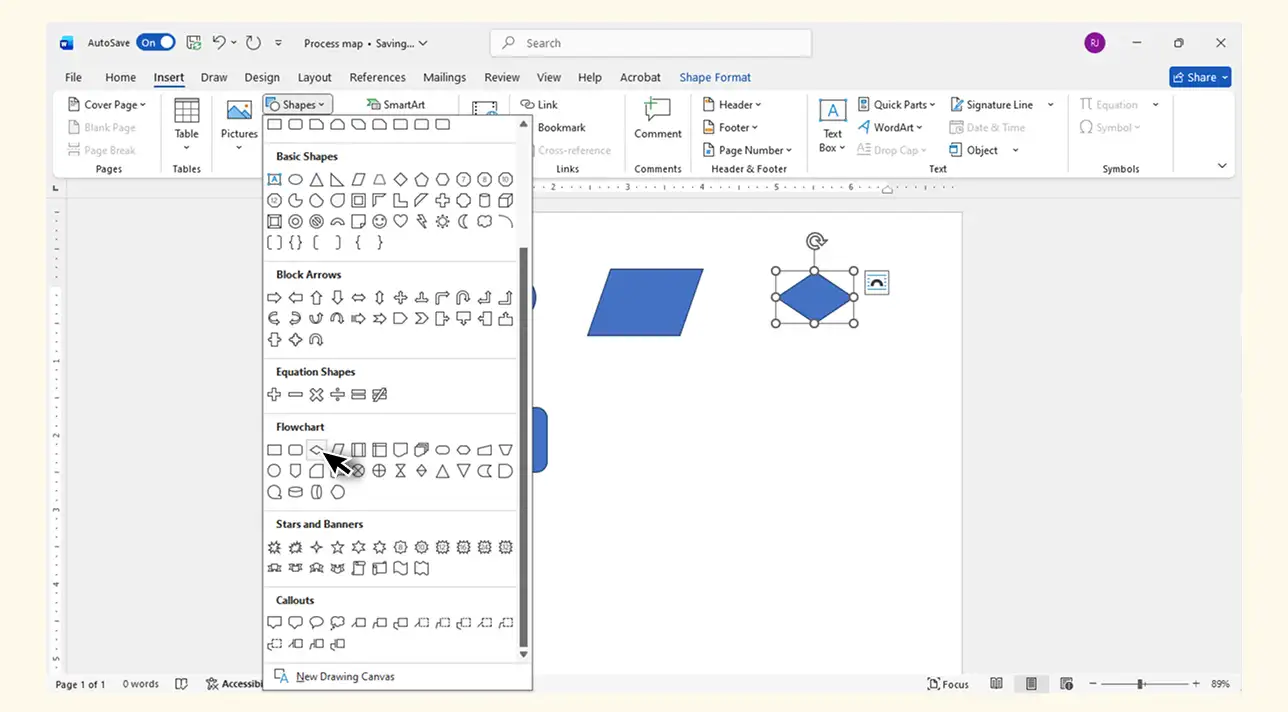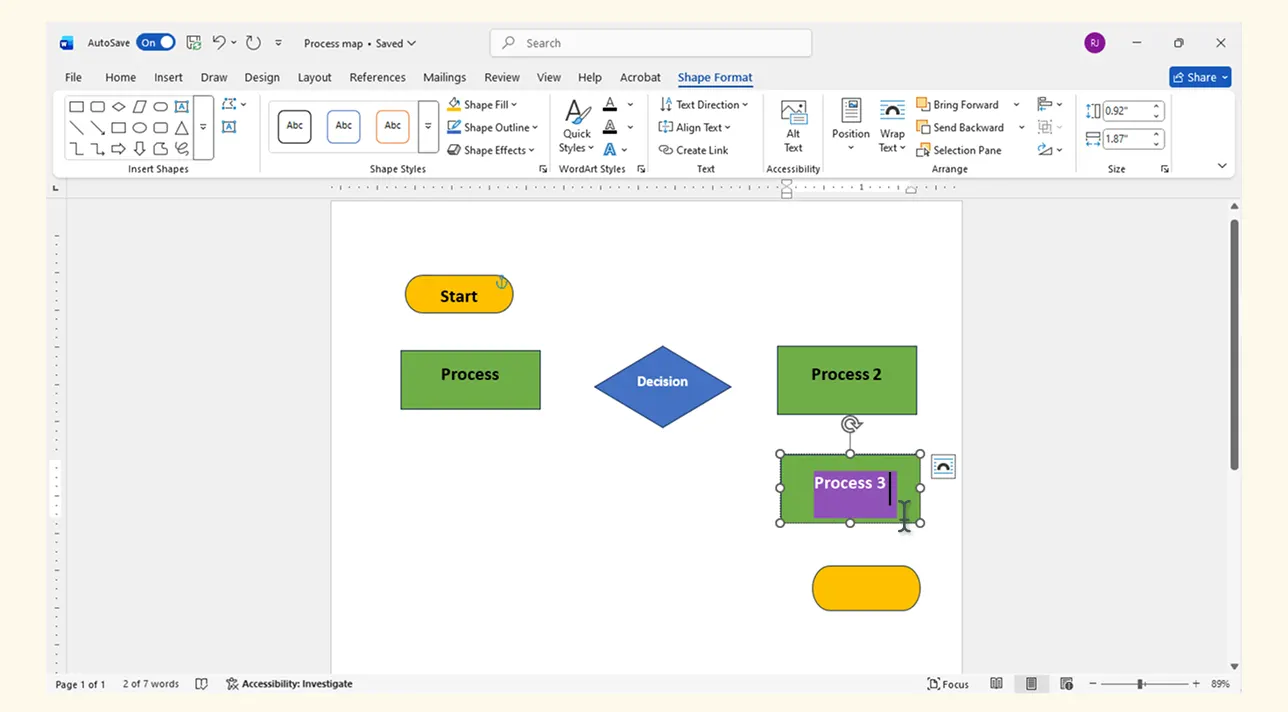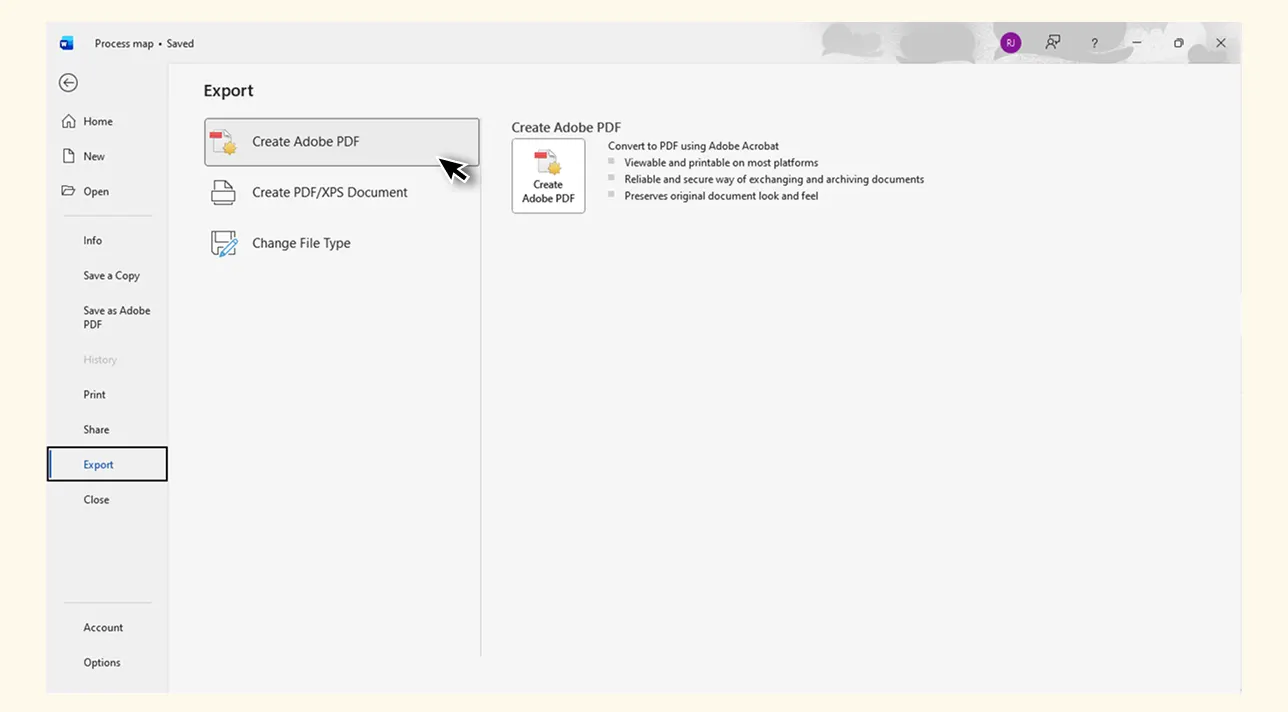If you want to learn how to do a process map in Word, then this is the guide for you. We cover step-by-step instructions, an understanding of the limitations of Microsoft Word, an alternative for making process maps, and a features comparison to help you choose the best option.
What is a Process Map?
A process map is a visual diagram that outlines how a workflow or business process functions. It uses shapes, connectors, and labels to represent steps, decisions, inputs, and outputs in a clear sequence. Process maps help teams understand how tasks flow from one stage to another, highlight inefficiencies, and improve overall clarity in operations. While basic diagrams can be assembled manually, creating detailed, well-structured process maps often requires careful formatting and layout adjustments to keep everything organized and easy to follow.
Read the process mapping guide to learn more about the different types, who can use process maps, and their benefits.
How to Make a Process Map in Word
Let’s go through the steps of how to draw a process map in Word.
Step 1: Open a Word Document
Start with a clean page so you have enough room to arrange shapes and build your diagram.

Step 2: Insert Flowchart Shapes
Go to Insert → Shapes and choose flowchart symbols such as process boxes, decision diamonds, and arrows. Word offers a basic set of shapes, so you may need to adapt them to match your workflow.

Step 3: Add and Arrange Your Steps
Place each shape in sequence and label them using text boxes or inline text. This part may take some manual adjustments to keep spacing and alignment consistent.

Step 4: Connect the Shapes
Use Lines or Arrows from the Shapes menu to indicate flow between steps. Be prepared to reposition connectors occasionally, as they don’t always stay attached when shapes are moved.

Step 5: Format Your Diagram
Customize colors, outlines, and text to make your process map easier to read. Word provides essential formatting tools, but complex layouts may require additional refinements.

Step 6: Export and Share Your Process Map
Once your diagram is ready, you can share it by exporting the document as a PDF or image, or by sending the Word file directly. Keep in mind that formatting can shift if collaborators edit the diagram, especially if shapes aren’t grouped.

Limitations of Creating a Process Map in Word
Word can handle very simple diagrams, but several limitations become clear as your process map grows or becomes more detailed.
No dedicated process mapping tools: Everything must be built manually using basic shapes, which slows down the workflow and requires constant formatting.
Limited symbol library: Word only includes a small selection of flowchart shapes, making it difficult to map complex, multi-layered, or industry-specific processes accurately.
Connectors aren’t smart: Lines and arrows don’t stay attached when shapes move, so reorganizing your map often leads to misaligned or disconnected steps.
Basic styling options: Customization for colors, line styles, and shapes is minimal, which can make larger diagrams look inconsistent without extra effort.
Hard to scale or revise: As the diagram becomes bigger, keeping everything aligned on a standard Word page becomes challenging, and even minor edits can require significant rework.
Limited diagram collaboration: Although Word supports document sharing, real-time co-editing of process maps is difficult because diagrams aren’t designed for team-based editing.
Word is suitable for quick, basic process visuals, but it can feel restrictive once you need cleaner layouts, easier updates, or collaborative process mapping. A dedicated tool built for diagramming like Creately offers a much smoother experience for creating clear, structured process maps.
Why Creately is the Best Alternative for Creating Process Maps
If you want a simpler, more powerful way to map and refine business processes, Creately’s process mapping software gives you everything Word can’t. Here’s what makes it the better choice for building process maps:
Ease of Use & Canvas Experience
No cramped document pages: Work on a spacious, infinite canvas instead of squeezing diagrams into a Word file.
Flexible layout freedom: Rearrange sections freely without being limited by page boundaries or text wrapping issues.
Symbols, Shapes & Templates
All the process symbols you need: Access full libraries of flowchart, workflow, and process mapping shapes, not just the basics.
Start instantly with ready-made templates: Choose from templates for workflows, swimlanes, SOPs, value streams, and more.
Reusable components: Save custom elements and layouts to speed up future process mapping sessions.
AI Flowchart Generator
Instant Diagram Creation: Create flowcharts and process charts from a simple prompt. Use Creately’s AI flowchart generator to automatically build the structure, layout, and connectors so your diagram is ready in moments.
Smart AI Suggestions: Get helpful suggestions for missing steps, related actions, and logical groupings to keep your flowcharts and process maps clear and well-organized.
Connectors & Layout Behavior
Smart connectors that behave correctly: Move a step and the lines automatically adjust with no tedious realignment.
Faster to update as processes evolve: Shapes snap, align, and reorganize smoothly, reducing layout fixes.
Styling & Visual Quality
Professional visuals without effort: Themes, color presets, and styling tools keep your process map clean and consistent.
Uniform formatting: Apply consistent styles across the entir e diagram, ensuring every section matches without manual adjustments.
Collaboration & Teamwork
Built for teams working together: Multiple people can map, comment, and refine processes in real time without conflicts.
Centralized collaboration: Keep feedback, discussions, and revisions next to the diagram so everyone stays aligned.
Scalability & Process Documentation
Grows with your process: The canvas expands effortlessly for detailed, multi-level diagrams or end-to-end systems.
Turn diagrams into real documentation: Add notes, attach files, and link sub-processes to build complete process documentation.
Modeling that keeps everything in sync: Update a step once and Creately reflects the change across all connected diagrams automatically.
Creately Vs Word: Process Mapping Features Comparison
Here’s how creating process maps in Word compares to using Creately’s dedicated process mapping tools.
Feature | Word | Creately |
Process Mapping Symbols | Limited basic shapes only | Extensive library of process, flowchart, workflow, and BPM symbols |
Connector Behavior | Lines and arrows detach when shapes move | Smart connectors that stay linked and auto-adjust |
Editing Environment | Fixed page layout with manual placement | Infinite canvas for freeform, flexible mapping |
Styling & Formatting | Basic color and shape customization | Professional themes, presets, and advanced styling tools |
Templates | No built-in process map templates | Dozens of ready-made templates for workflows, SOPs, swimlanes, and more |
Collaboration | Document sharing only; diagrams don’t update well with multiple editors | True real-time co-editing with comments and multi-cursor visibility |
Scalability | Difficult to maintain structure in large or complex maps | Easily handles simple to multi-level, detailed process diagrams |
Export Options | Limited export formats (PDF/image) | High-quality PNG, SVG, PDF, embeds, and more |
Linking & Documentation | No option to link steps to notes or related diagrams | Add files, notes, sub-process links, and detailed documentation |
Advanced Modeling | Not supported | Data-driven modeling that updates all connected diagrams automatically |
Best Use Case | Basic, small process visuals | Complete process documentation and end-to-end workflow mappingc |
Free Process Map Templates to Get Started
Helpful Resources for Making Process Maps
Explore the different types of process maps and how they are used.
Learn step-by-step how to make a process map in Microsoft Excel.
Understand the four levels of business process mapping.





